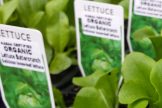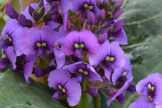
Spring is here, so get excited. All the spring / summer seeds are now out on display with a huge variety to choose from. Maybe this season try your hand at sowing a different variety of your favourite veg that you wouldn’t find on our seedling bench. An Armenian Cucumber or a Thai pea eggplant, A Selway Red Lettuce or even a Cocozelle Zucchini to name a few.
Not forgetting an amazing assortment of herbs and flowers. A great mix of basil is always popular at this time of year and I don’t think you can go past a few Sunflowers, Cosmos or Zinnias for that amazing pop of colour and to liven your garden up. Remember, that with seeds you have many more choices than seedlings and that makes it so much more fun.
Happy seed sowing from Cathy!
Seeds are easy!
Growing your own herbs, fruit and vegies from seed is fun, easy and will save you loads of money. Not everything is easy to grow from seed, but you will be surprised how many things are. We have been working hard over the past couple of years to really beef up our seed range, so if you decide to give growing from seed a go you will be pleasantly surprised at the wide variety you will be able to choose from.
The many benefits of growing from seed.
It is HEAPS cheaper! Depending on the type of seed you can get hundreds of plants from just one packet. A packet of seeds generally costs about the same as one tray of ten or so seedlings. Who doesn’t love a bargain.
Organic anyone? By growing your food from seeds you will know exactly what has been used in the growing process. If you are interested in strictly organic food there is no better way to have peace of mind than by using seeds.
It is better for the environment. There are quite a few ways that growing from seed will help reduce your footprint. While growing from seedlings is still better than buying from the supermarket, growing from seed is better still. The transport requirements and packaging are much lower for seeds than for seedlings.
You can collect the seeds and grow next year’s crop for free! If you use non-hybridised seeds, you will be able to collect the seeds every year and re-plant them… or better yet start a seed-swapping group with a few friends.
Kids love seeds. You will find your kids have loads of fun planting the seeds and seeing the new plants pop their heads out of the soil. Seeds are the perfect way to get your kids hooked on gardening. Even little kids can get involved, just use bigger seeds (like broad beans) so their little fingers can manage them easily.
Way more variety. When buying seedlings, you are pretty much limited to the most popular few varieties. This is because the growers only grow what they know is going to sell. Makes sense for them really, but that doesn’t help you out much. By using seeds, you can experiment with some really bizarre and unusual varieties, some of which have a taste that will leave you speechless. Or a little surprised at least. Many hard core vegie gardeners will only grow Heirloom varieties because of the amazing range of shapes, sizes, colours and (most importantly) tastes that are available.
Most seeds are easy to grow.
Some seeds can be planted directly into the garden. Things like peas, corn and beans as well as root vegetables like beetroot and carrots can all be planted in your vegie patch. Other more delicate seedlings will need to be raised in a container or tray until they sprout, and can then be transplanted into the garden. The seed packets will all have easy-to-follow instructions printed on the back so that even the biggest gardening nuffy will be gorging on fresh seed-grown produce in no time. Depending on the type and time of year, you may also need to grow them indoors on a window sill (or in a seed propagator).
Growing Summer Vegies from Seed
If you love growing your own vegetables over summer then you’ll be pleased to know that many of them are easily grown from seed. The most popular vegetables such as tomatoes, cucumber, pumpkin, zucchini, beans and corn are great for beginners and there are many advantages to choosing seeds over seedlings.
Growing from seed is a fantastic activity for kids, especially fast growing things such as sunflowers, beans, corn and peas. Children can collect egg cartons and toilet rolls to make their own compostable pots.
I feel the need… the need for seed.
Seeds are much cheaper than seedlings and will generally last a couple of years if stored correctly, as long as the use-by date is still current.
You have a much greater choice if you grow from seed, as only a small selection of the most popular vegetable varieties are produced as seedlings. You are not limited to what is available at the local nursery but can also take advantage of mail-order seed companies. Another advantage is the smaller energy requirement to transport seeds rather than heavy plants and seedlings.
If you prefer to grow organic produce, choose seeds, as most seedlings aren’t produced organically, whereas there is a large range of organic seeds available.
If you grow open-pollinated, non-hybrid seed then you can save your own seed from year to year and cut out the middleman all together. Seed saving is a delight all of its own!
Growing from seed means that you can save space in the garden by propagating many plants close together, in a separate area first, rather than having to make room in the garden. Having your seedlings growing in a protected, sheltered area makes it easier to protect them from the cold and also from insects, snails and slugs. It allows you to get your plants growing strongly, ready for planting once the soil temperature has increased and they are more resilient to attack.
Propagating some vegetables first also means that, if you are pressed for time, you can simply check your seedlings for watering, rather than the garden beds, as your seeds and emerging seedlings will require more frequent attention than the established vegetables.
What do I need to seed?
Collect a few items first, before getting started. Seeds can be grown in egg cartons, toilet rolls or newspaper pots. You can also propagate them in washed second hand punnets or seedling trays. If you are using toilet rolls snip at frequent intervals around the base and then fold in to create a bottom.
You also need a growing medium and seed raising mix or potting mix is fine. Potting mix can be a bit coarse so sift if necessary to get the big bits out.
You need a place to put the seeds once you have sown them. A warm, sheltered spot away from frost is best. This can be on the veranda, a sunny windowsill or under a cold frame or plastic cover.
Be careful not to disturb the seeds with watering so use a very fine rose on your watering can or a spray bottle.
Are you direct or indirect? To sow direct means to plant the seed straight into the garden bed. This is normally done for larger seeds or very fine seed that does not like to be disturbed, such as carrots or onions. Beans can be sown directly, for example, as they are large, easily spaced out and they germinate easily. The instructions on the back of the seed packet will tell you whether to sow direct or indirect.
Pricking Out
The term pricking out means to gently move the new seedlings into a larger pot, and is done if the seedlings have been propagated in a punnet or tray rather than individually. Use a chopstick or similar item to lever the seedlings out from below, being careful not to pull on the leaves or stalk. This is generally done once the seedling has the first true leaves or is about an inch long. Place into a larger pot prepared with potting mix and firm the soil around the roots gently. It is much better to plant deeply at this stage, especially with tomatoes, as the seedling may fall over if it is too shallow and tomatoes will develop roots along the stem.
If you have grown your seeds individually in compostable pots, such as toilet rolls or jiffy pots, then you can simply plant them straight into the garden once they are large enough and the weather has become warmer.
Have a go at seed raising this summer and enjoy the satisfaction of growing from seed all the way to the final vegie on your dinner plate.
You will need to be careful when watering newly planted seeds as they can be quite fragile until they take root, especially the tiny seeds like carrots. You can water using a mister or a very fine spray.
Whatever seeds you may be interested in growing, come down and have a chat to one of our nursery staff. They will give you all the info you need.





